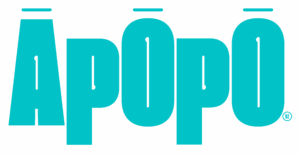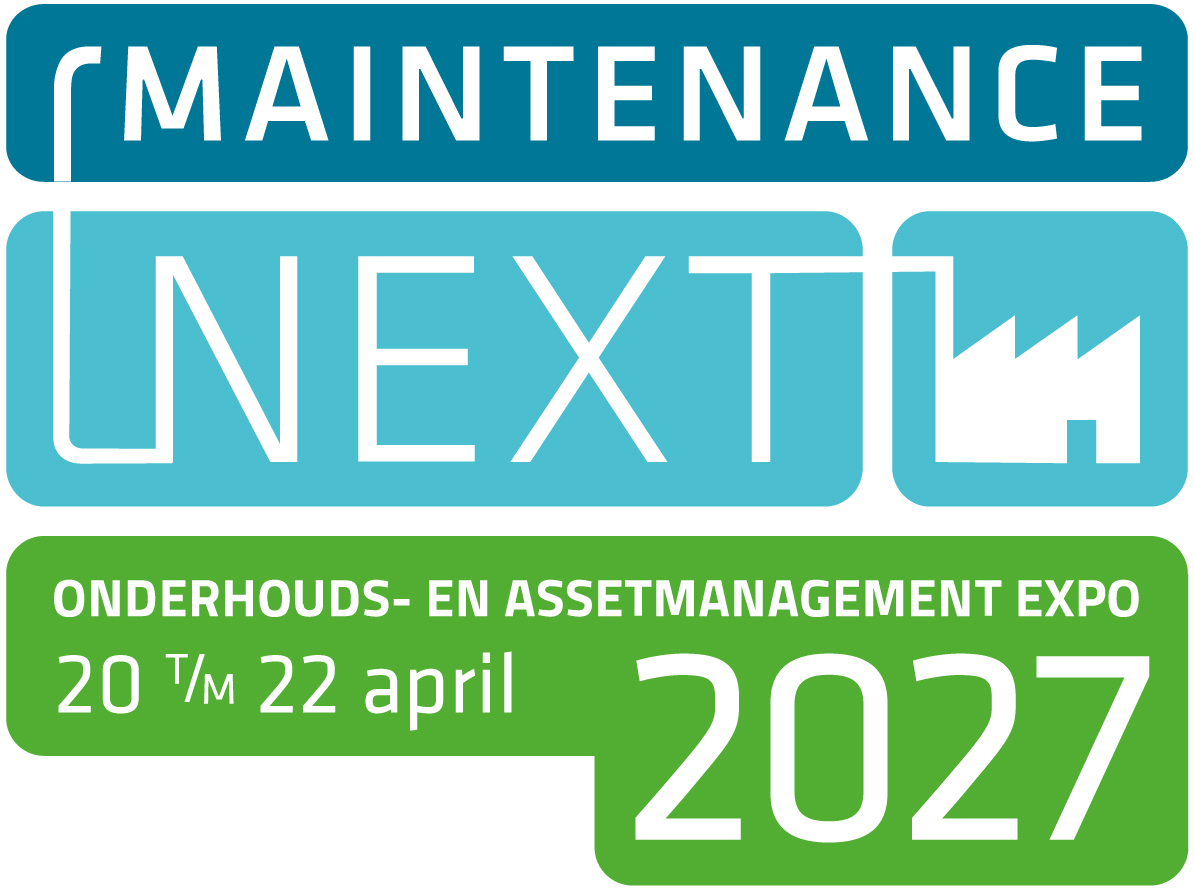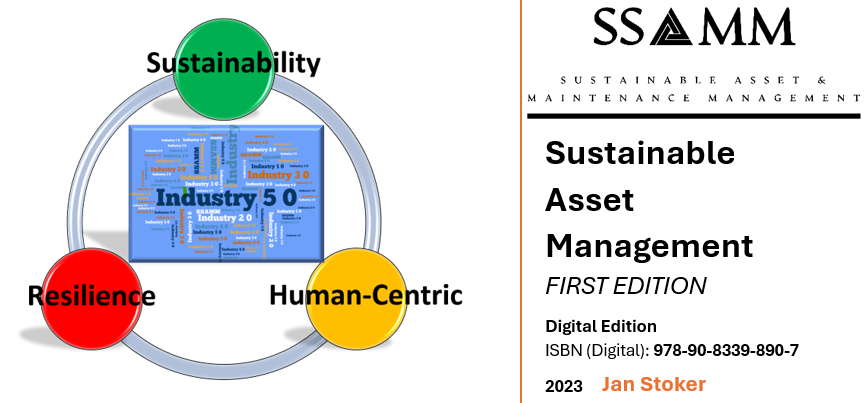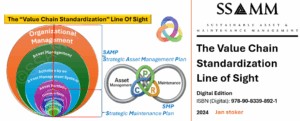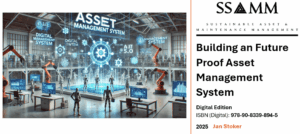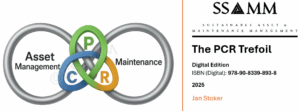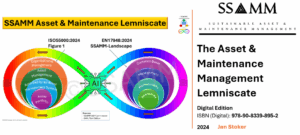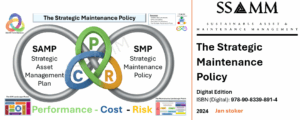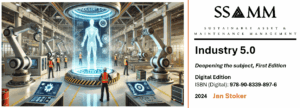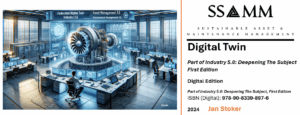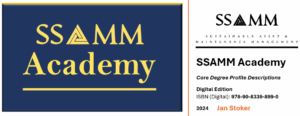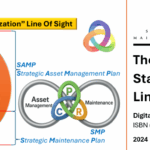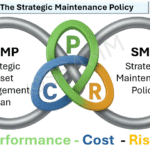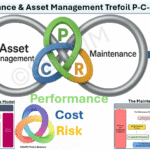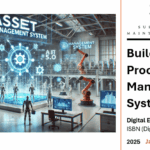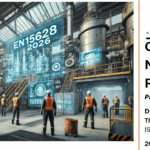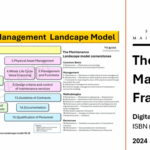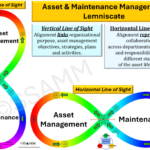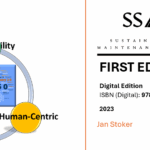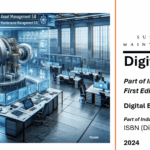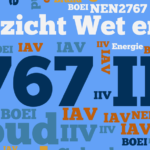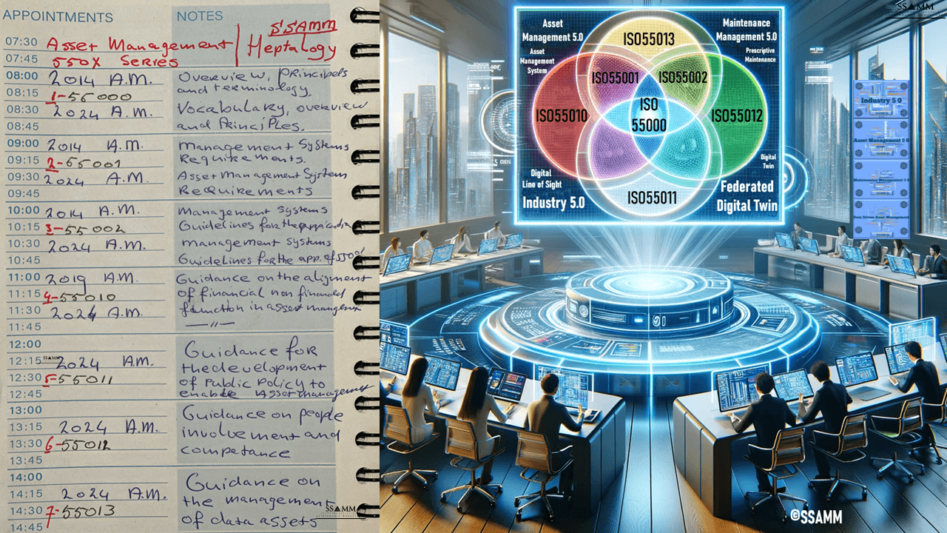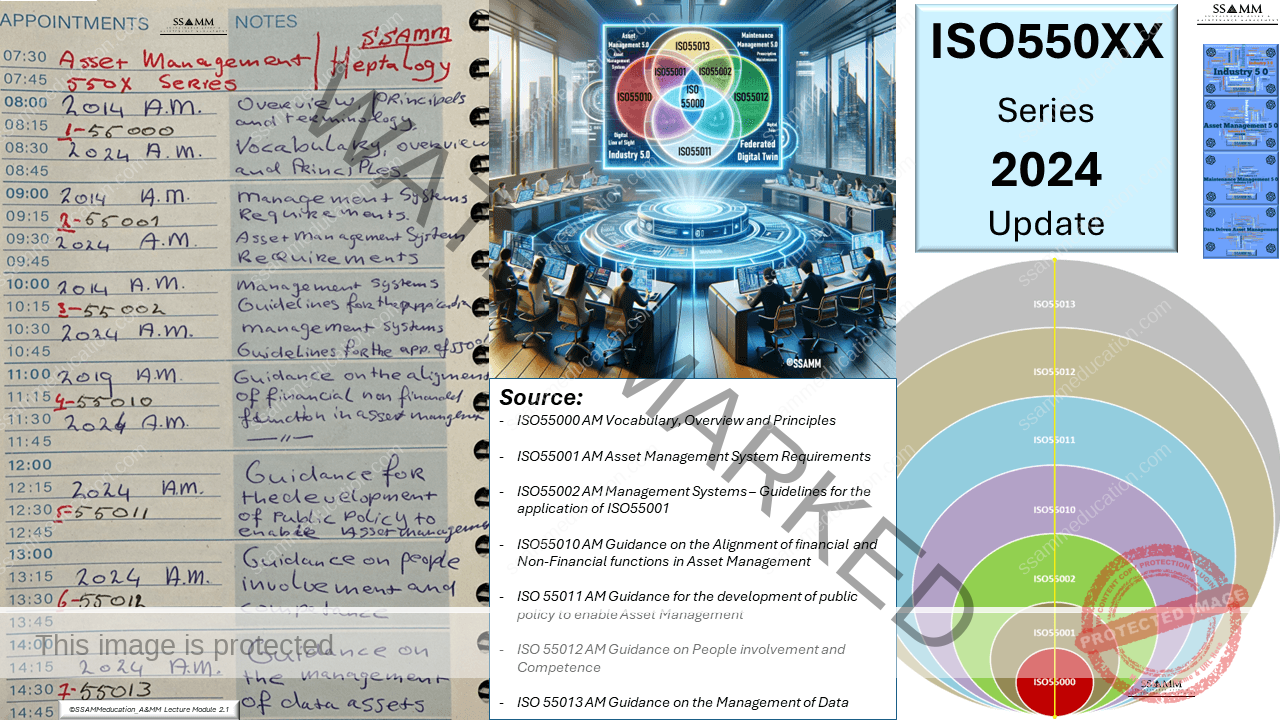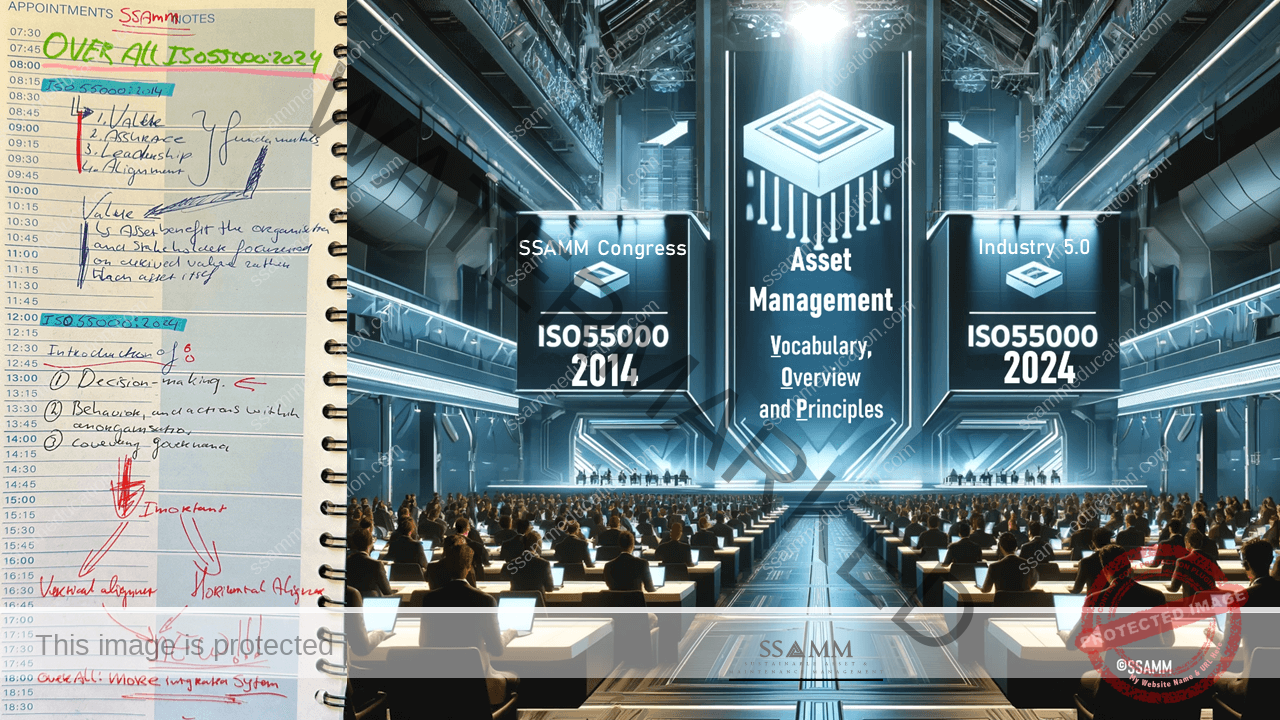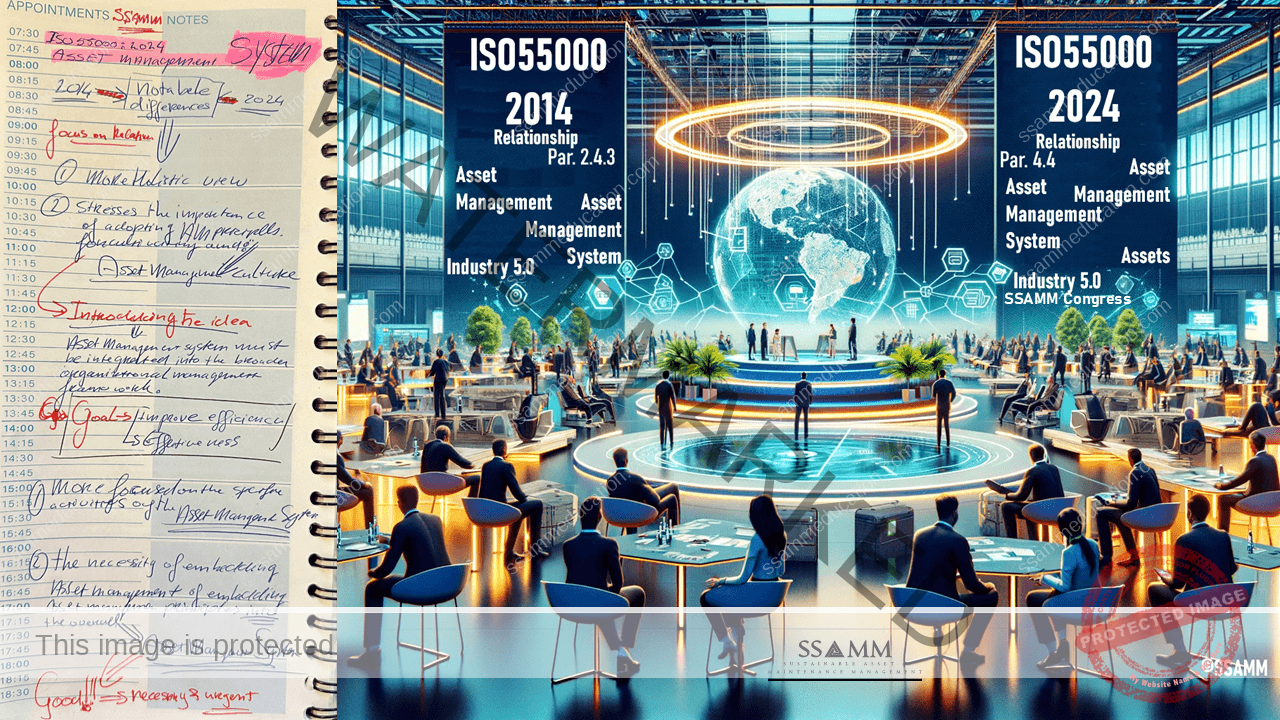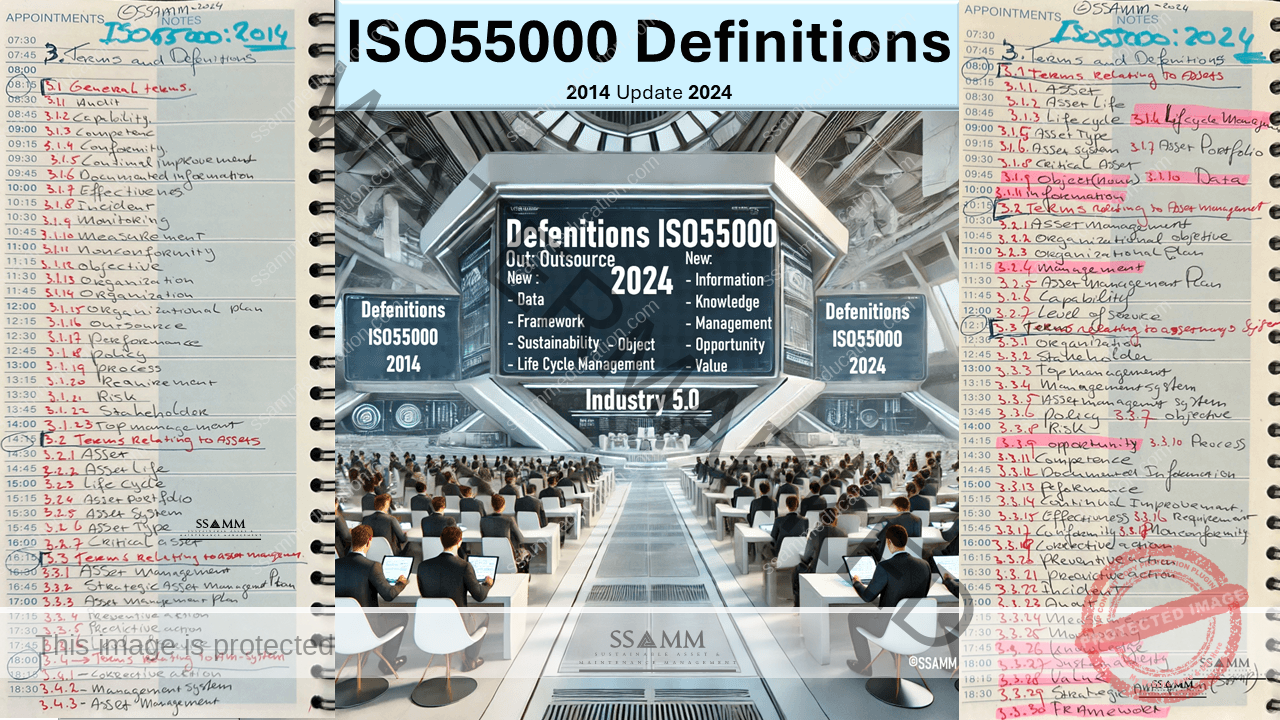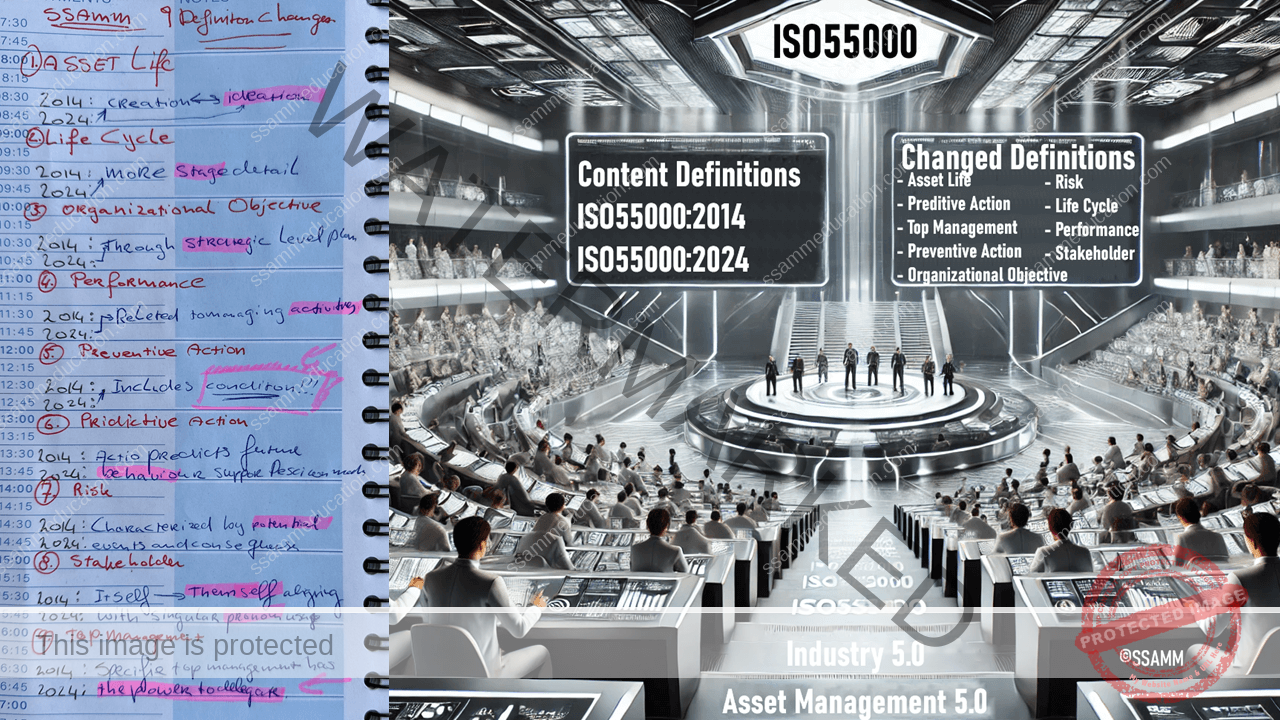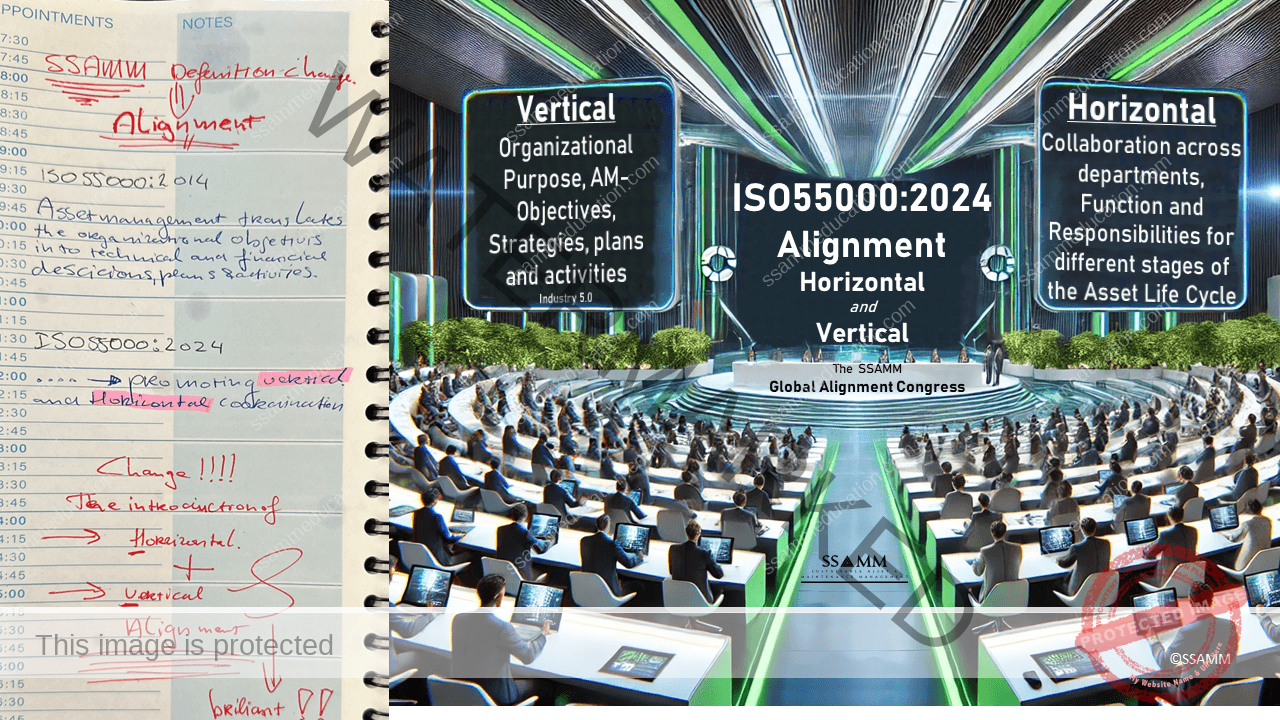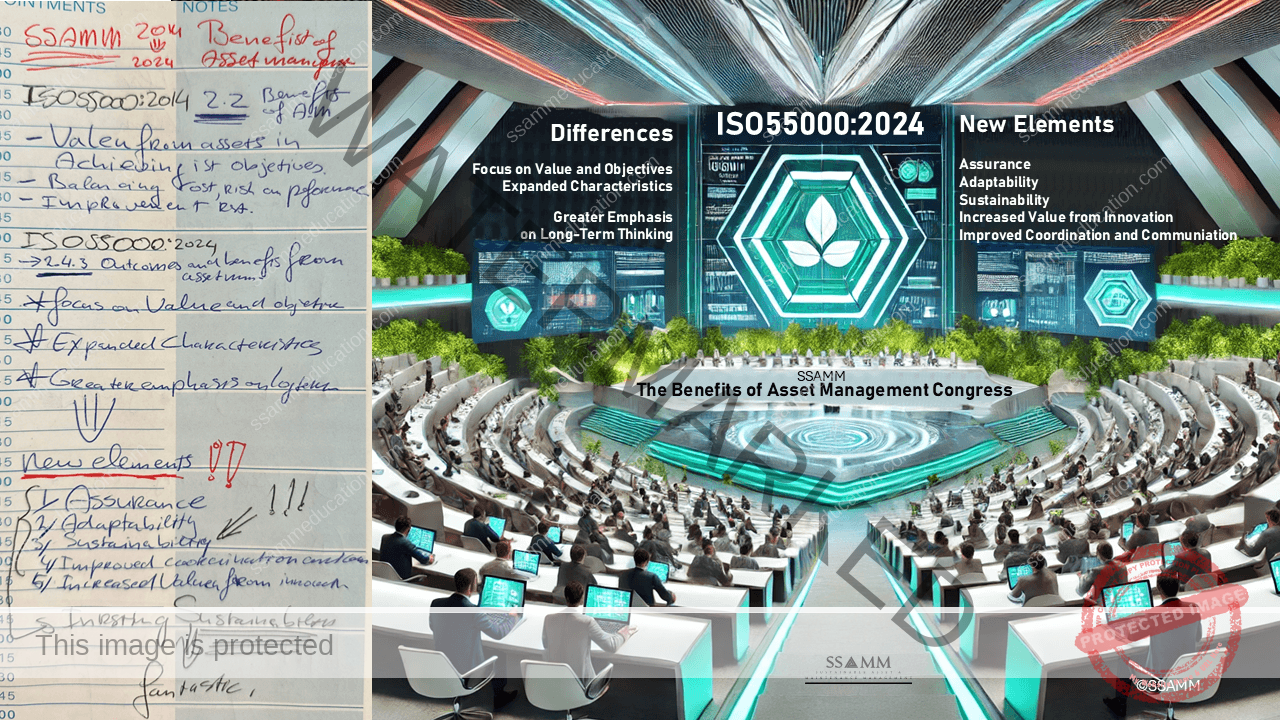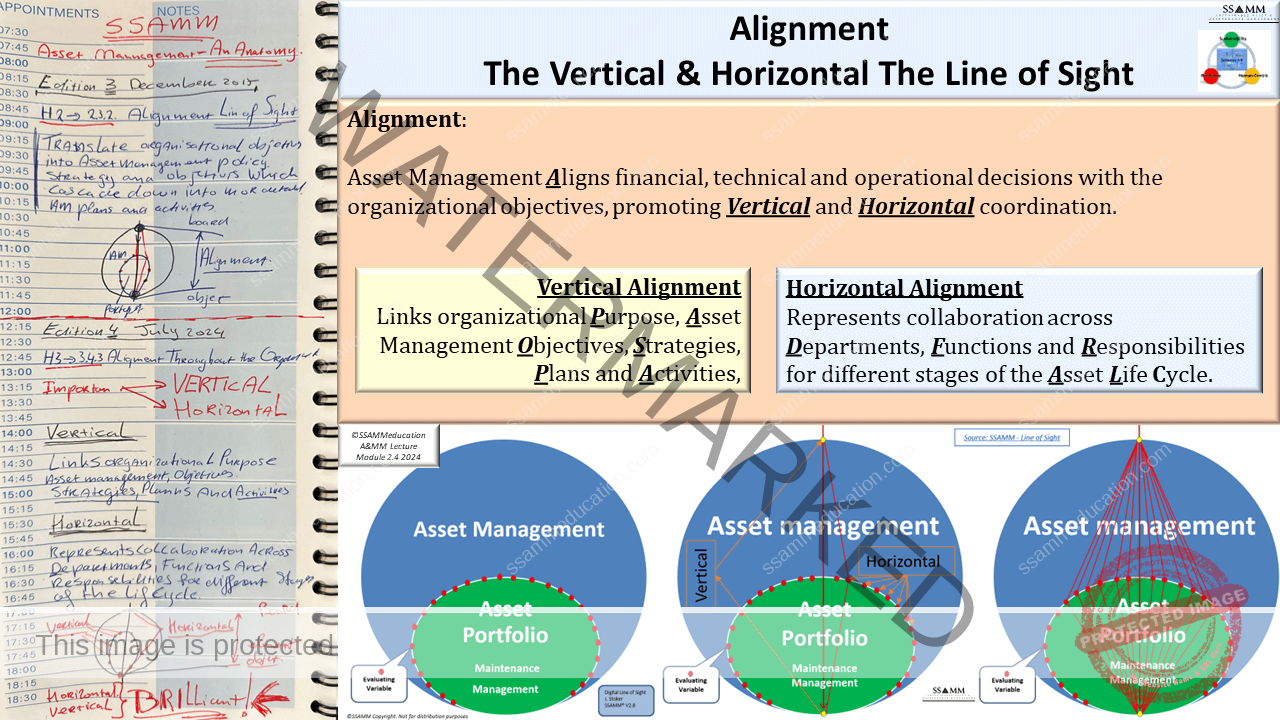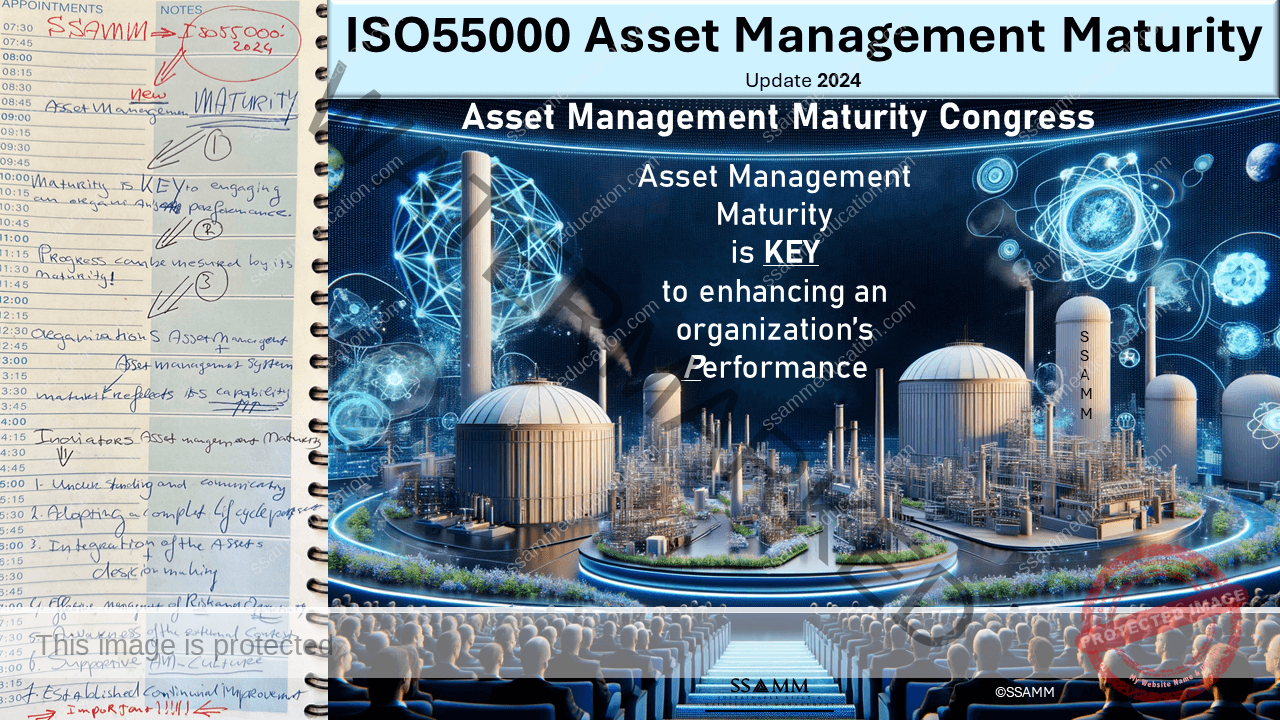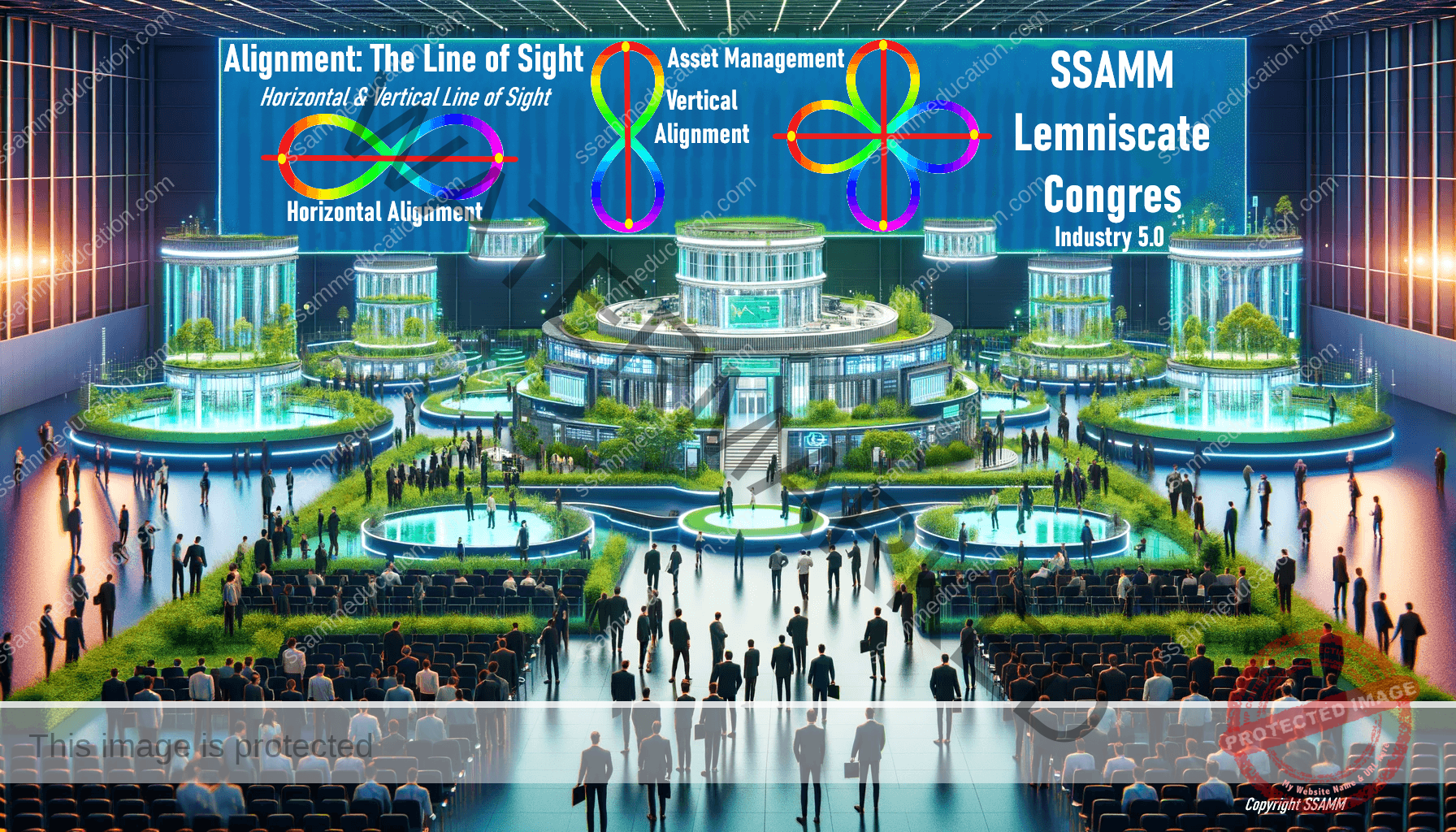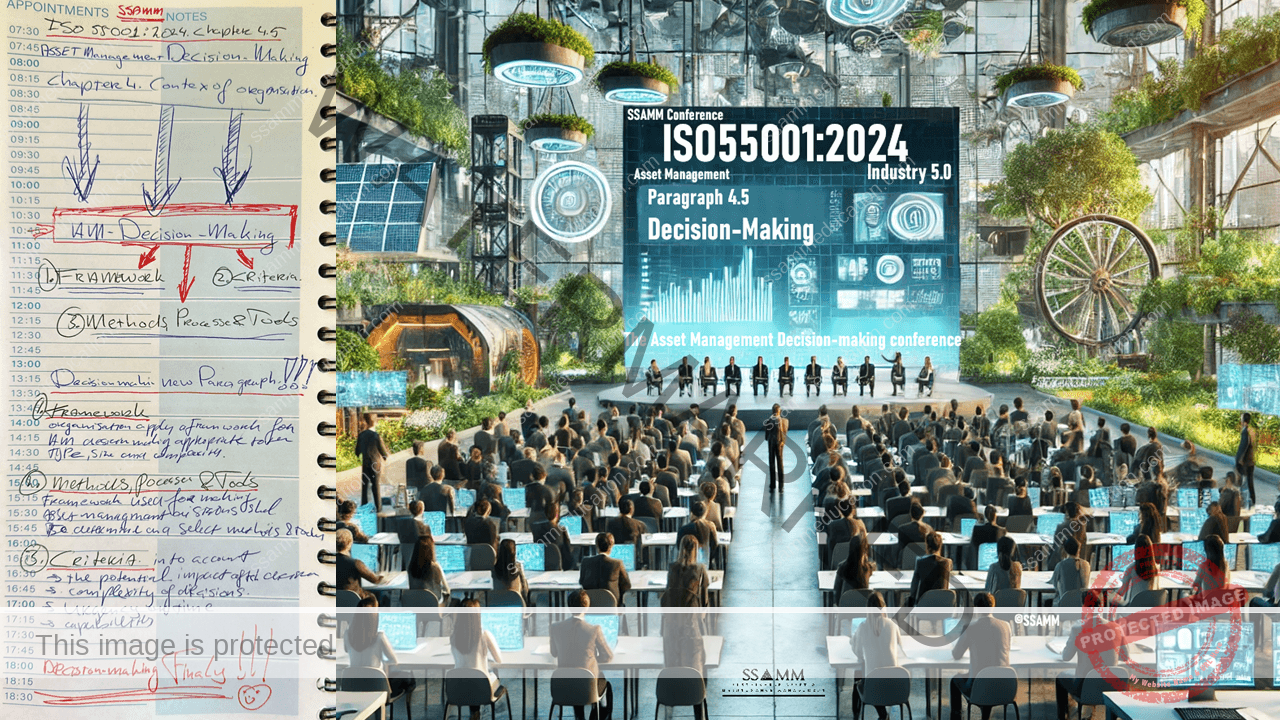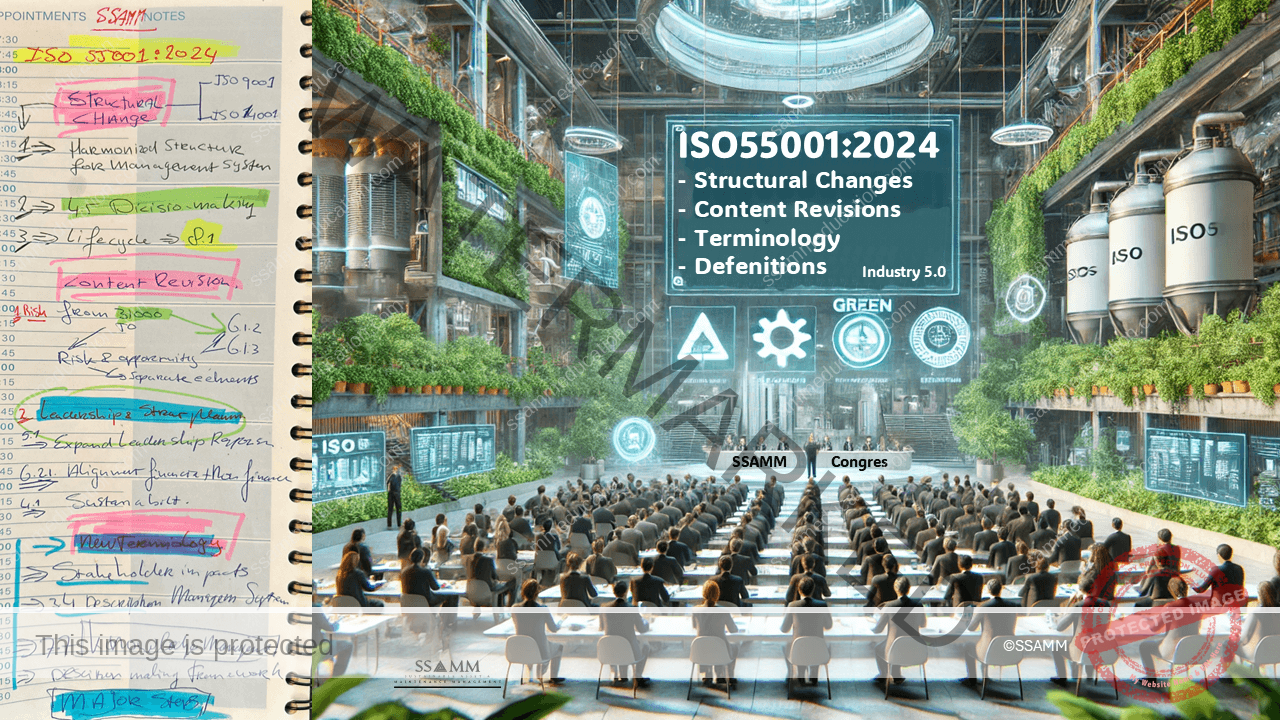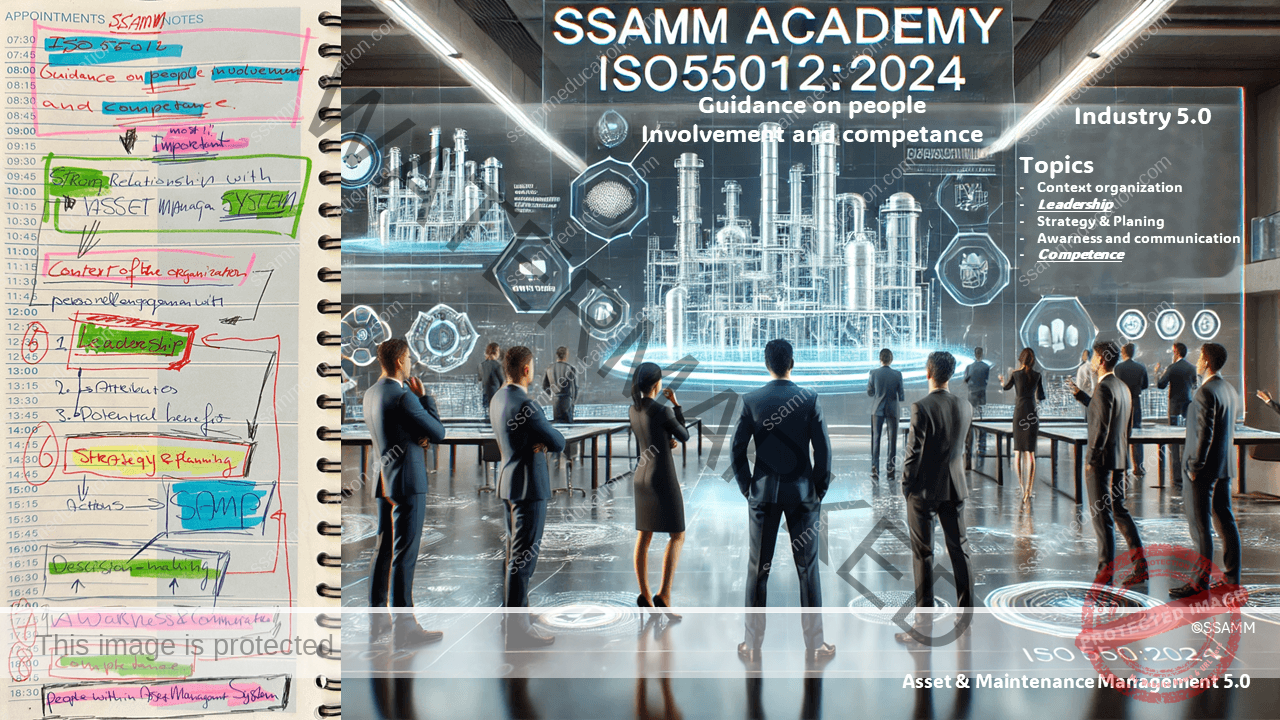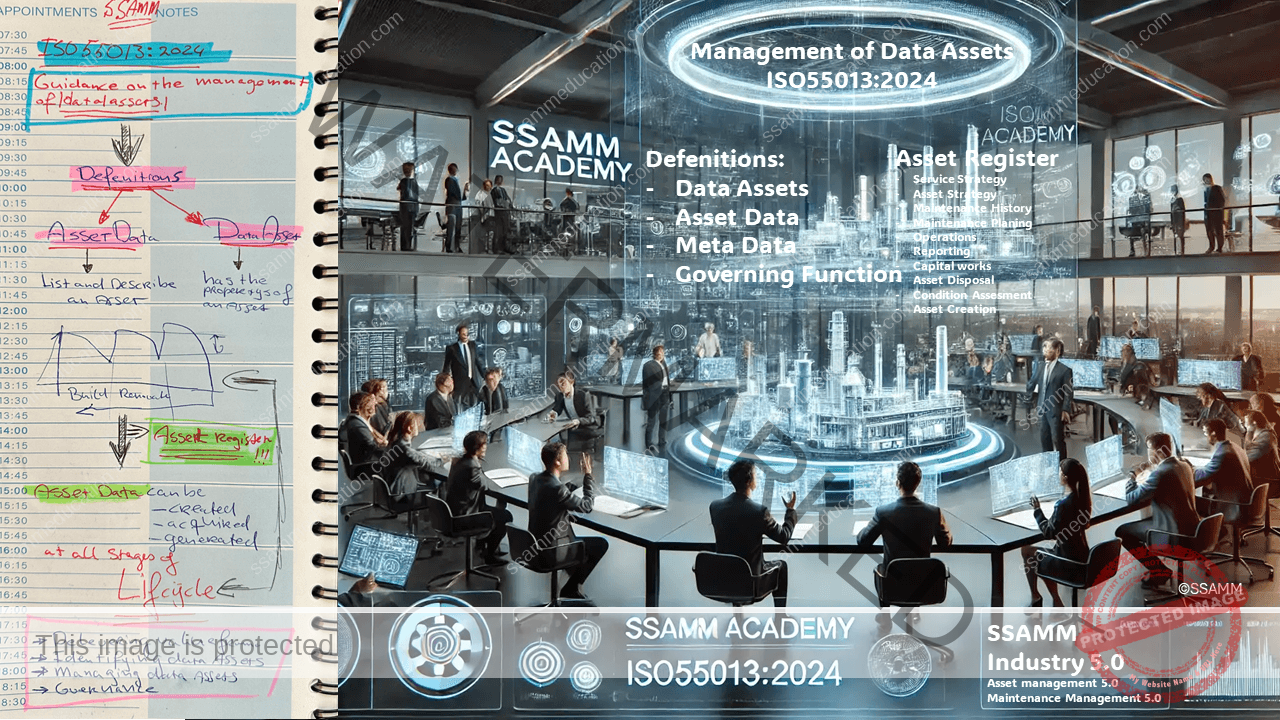In the dynamic and ever-evolving field of Asset and Maintenance Management, staying abreast of the latest standards and best practices is crucial for ensuring the sustainability and efficiency of organizational assets. The ISO550XX:2024 series represents a significant advancement in the Industry 5.0 timeframe, offering comprehensive guidelines that enhance the alignment of asset management strategies with organizational objectives. This upgrade comes amidst the Industry 5.0 timeframe, emphasizing the integration of human intelligence with advanced technologies for enhanced efficiency and sustainability in Asset management.
This page provides an exploration of the ISO550XX:2024 standards, encapsulating essential insights and practical applications that are vital for practitioners, academics, Maintenance Engineers and industry leaders alike. The insights presented here are part of the broader in-depth narrative detailed in the book “Sustainable Asset Management” (SAM), which serves as a definitive resource for understanding and implementing Sustainable Asset Management practices. Moreover, this overview is closely connected with the discussions and resources available on the LinkedIn page, Sustainable Asset Management. This platform extends the conversation on Sustainable Asset Management practices, facilitating knowledge exchange and collaboration among professionals globally.
Maintenance Fundamentals SAM, First Edition Keynote Āpōpō Congres 2026 Follow Sustainable Asset Management for latest updates
Countdown SSAMM Academy Module 1
Explore the SSAMM Academy Asset Management and Maintenance Management courses.
Click Here for the Smart information page
Author: Ing. Jan Stoker MSc. MEng. AMCP. CFAM. Follow Jan Stoker
Introduction
The ISO55000 series of standards, essential for Asset and Maintenance Management, are experiencing substantial updates with the release of ISO550XX:2024. These updates are designed to refine and enhance the framework for establishing, implementing, maintaining, and improving effective asset management systems, ensuring they address contemporary industry challenges and leverage technological advancements.
This page provides a comprehensive overview and insights into the ISO550XX:2024 upgrade, with a specific focus on the changes and improvements from the ISO550XX:2014 standards. Each chapter is dedicated to a specific standard within the series, such as ISO55000, ISO 5001, ISO55002, and others, detailing the revisions and enhancements introduced in the 2024 edition.
By structuring the content into individual chapters for each standard, we offer a clear and systematic presentation of the upgraded elements and requirements, along with a thorough comparison between the 2014 and 2024 versions. This approach facilitates a deeper understanding of how the ISO 550XX:2024 series strengthens the foundation of sustainable asset management and aligns with the evolving needs of the industry.
In the subsequent sections, you will find detailed chapters that explain the specific objectives, scope, implementation guidelines, and key changes of each ISO standard within the 550XX:2024 upgrade, providing a valuable resource for practitioners and scholars in the field.
2024 Asset Management ISO 550XX Update
This update encompasses several key standards that will provide enhanced guidance and requirements for organizations striving to optimize their asset management practices. The revised standards are:
ISO55000: Asset Management – Vocabulary, Overview, and Principles
Offers a comprehensive vocabulary and overview of asset management. It sets forth the fundamental principles, serving as the cornerstone for understanding and implementing effective asset AM practices.
ISO55001: Asset Management – Asset Management System Requirements
Outlines the specific requirements for an asset management system. It provides a structured framework for establishing, implementing, maintaining, and improving an organization’s asset management system.
ISO55002: Asset Management – Management Systems – Guidelines for the Application of ISO55001
Delivers detailed guidelines for applying the requirements of ISO 55001. It aids organizations in tailoring their AM-System to meet their unique needs and contexts.
ISO55010: Asset Management – Guidance on the Alignment of Financial and Non-Financial Functions in Asset Management
Offers guidance on harmonizing financial and non-financial functions. This alignment is crucial for ensuring that AM decisions are financially sound and support overall organizational objectives.
ISO55011: Asset Management – Guidance for the Development of Public Policy to Enable Asset Management
Provides advice on crafting public policies that support and enable effective asset management. This standard is particularly valuable for policymakers and public sector organizations.
ISO55012: Asset Management – Guidance on People Involvement and Competence
Emphasizes the importance of people in AM. It offers guidance on engaging and developing the competence of personnel involved in asset management activities, ensuring they have the skills and knowledge necessary to contribute effectively.
ISO55013: Asset Management – Guidance on the Management of Data
Focuses on the management of data in AM. It provides guidelines for ensuring that data used in asset management is accurate, reliable, and effectively utilized to inform decision-making.
1. ISO55000: Asset Management – Vocabulary, Overview, and Principles
Offers a comprehensive vocabulary and overview of asset management. It sets forth the fundamental principles, serving as the cornerstone for understanding and implementing effective asset AM practices.
1.1. Compare ISO55000:2014 V.S. ISO55000:2024
Alignment translates organizational objectives into technical and financial decisions, integrating them with finance, human resources, and logistics processes. This ensures that risk-based, information-driven planning and decision-making transform objectives into AM plans.
Leadership requires commitment from all managerial levels. Clear roles, responsibilities, and authorities, along with engaging and empowering employees and stakeholders, foster a supportive culture.
Assurance ensures assets fulfill their purposes by linking performance to organizational objectives, maintaining capability across all life cycle stages, and providing resources and competent personnel for AM.
In contrast, the ISO55000:2024 version introduces principles as guidelines for decision-making, behavior, and actions within an organization, covering governance, ethics, and operations. The focus on Value remains, emphasizing the contributions assets provide over time to organizational objectives, LCM and transparent decision-making.
Alignment in the 2024 version stresses the coordination of financial, technical, and operational decisions with organizational objectives, promoting both vertical alignment (linking organizational purpose to asset management strategies and activities) and horizontal alignment (collaboration across departments and functions throughout the asset life cycle).
Leadership in the 2024 version emphasizes sustained commitment at all levels for successful AM. Effective leadership involves setting a clear direction, defining roles and responsibilities, and fostering a collaborative culture aligned with organizational success.
Overall, the 2024 version reflects a more integrated and systematic approach, broadening the scope to include organizational culture and values. It emphasizes transparency, sustained commitment, and collaboration more strongly than the 2014 version, indicating an evolved understanding of leadership and alignment in AM.
1.2 The Shift from Four to Three fundamental Principles of Asset Management
1.2.1 Introduction
The evolution of the fundamental principles of asset management, as reflected in the transition from ISO 55000:2014 to ISO 55000:2024, represents a major conceptual shift in the discipline. The 2014 version identified four fundamental principles: Value, Alignment, Leadership, and Assurance. The 2024 revision consolidates these into three principles by removing Assurance as a distinct category. This modification reflects a broader integration of assurance as an outcome rather than a standalone principle. This article examines the rationale behind this transition and the implications for asset management practices.
1.2.2 The Fundamental Principles in ISO55000:2014
ISO 55000:2014 structured asset management around four key principles that guided decision-making and operational strategies.
1.2.2.1 Value
The principle of Value emphasized that assets are not ends in themselves but means to deliver tangible and intangible benefits to organizations and stakeholders. This principle underscored:
-
The explicit alignment of asset management objectives with organizational goals.
-
The application of life cycle management to optimize asset value.
-
Decision-making processes that incorporate stakeholder needs to define and assess value effectively.
1.2.2.2 Alignment
Alignment in ISO 55000:2014 stressed the importance of translating organizational objectives into financial, technical, and operational asset management decisions. It included:
-
The use of risk-based, data-driven planning and decision-making processes.
-
The integration of asset management with other organizational functions such as finance, human resources, and logistics.
-
The development and implementation of a structured asset management system.
1.2.2.3 Leadership
Leadership was recognized as a fundamental principle shaping organizational culture and fostering commitment at all levels. It encompassed:
-
Clearly defining roles, responsibilities, and authorities.
-
Ensuring that employees were well-informed, competent, and empowered.
-
Engaging stakeholders and employees in asset management decision-making.
1.2.2.4 Assurance
The principle of Assurance provided confidence that assets would fulfill their intended purpose. This principle was essential for:
-
Establishing processes that link asset performance to organizational objectives.
-
Implementing assurance mechanisms across asset life cycle stages.
-
Developing monitoring and continual improvement processes.
-
Ensuring the availability of necessary resources and competencies to support assurance activities.
Click to enlarge
1.2.3 The Fundamental Principles in ISO55000:2024
The 2024 revision of ISO 55000 refined the fundamental principles, consolidating them into three: Value, Alignment, and Leadership. This revision eliminates Assurance as an independent principle, instead embedding it as an inherent outcome of effective asset management.
The revised principle of Value continues to emphasize:
-
The long-term contribution of assets to organizational objectives.
-
The role of life cycle management in sustaining and optimizing asset performance.
-
Transparent decision-making that ensures stakeholder awareness of asset value.
Alignment remains crucial in ISO 55000:2024, reinforcing the need to synchronize financial, operational, and technical decisions with organizational objectives. The updated framework highlights:
-
Vertical alignment, connecting strategic intent to operational execution.
-
Horizontal alignment, ensuring collaboration across departments and functions.
-
Greater integration of asset management processes within broader organizational governance structures.
1.2.3.3 Leadership
Leadership continues to be a key determinant of asset management success. The revised principle underscores:
-
The importance of sustained commitment from leadership at all levels.
-
Clearly defined roles, responsibilities, and governance frameworks.
-
The necessity of transparent consultation and a collaborative culture that aligns with organizational objectives.
1.2.4 The Integration of Assurance as an Outcome
The removal of Assurance as a standalone principle in ISO 55000:2024 signifies a shift in how organizations are expected to approach asset management assurance. Rather than treating it as an independent pillar, assurance is now considered an embedded outcome of effective alignment, leadership, and value-driven decision-making. This shift suggests:
-
Assurance mechanisms are inherently part of a well-structured asset management system.
-
Leadership and governance processes are expected to incorporate assurance within their scope.
-
Continuous improvement, risk management, and compliance functions are integrated within the broader asset management framework.
While this transition simplifies the principle framework, it also challenges organizations to rethink how they demonstrate confidence in asset performance and governance. Organizations will need to ensure that assurance mechanisms are seamlessly embedded within their leadership and decision-making processes rather than treating them as separate assurance activities.
1.2.5 Wrap up
The transition from ISO55000:2014 to ISO55000:2024 represents a significant restructuring of the fundamental principles of asset management. By consolidating the principles into three—Value, Alignment, and Leadership—the updated framework seeks to streamline and integrate assurance within broader asset management practices. While the removal of Assurance as a standalone principle reflects an emphasis on embedding assurance mechanisms within governance and leadership structures, it also raises considerations for organizations in demonstrating compliance and capability. This evolution underscores the need for asset management strategies to be adaptable, ensuring alignment with changing industry standards and organizational needs.
1.3 Relationships Asset Management and Asset Management System
However, it also acknowledges that certain influential aspects, such as leadership, culture, motivation, and behavior, might be managed outside the formal AMS. This version presents a somewhat limited scope of the AM, highlighting that not all activities can be formalized within it.
In contrast, the 2024 version expands on this by integrating a more holistic view. It not only reiterates the role of the AMS in directing, coordinating, and controlling activities but also emphasizes that assets are vital for business success when they align with organizational strategies and policies. This version stresses the importance of adopting Asset Management principles for cultivating an effective Asset Management culture.
It introduces the idea that the Asset Management System should be integrated into the broader organizational management framework, aligning with various management systems to improve efficiency and effectiveness. This approach includes leveraging the Harmonized Structure, facilitating easier adoption of new systems, and enhancing process management. Moreover, it provides specific examples, such as integrating risk management approaches, to illustrate the practical benefits of this comprehensive integration.
The primary differences between the two versions lie in the scope and integration of the asset management system and direct relation with ISO55001 and ISO55002. The 2014 version is more focused on the specific activities within asset management and acknowledges external factors that influence it. In contrast, the 2023 version provides a broader, more integrated approach, emphasizing the value of assets in achieving organizational objectives and the necessity of embedding Asset Management principles into the overall management system. This integrated approach aims to streamline management activities and accelerate the benefits derived from asset management practices.
1.4 New definitions in the ISO55000:2024.
The ISO55000 series provides an international framework for Asset Management (AM). The latest revision, ISO55000:2024, includes significant updates in terminology to enhance clarity. We checked new definitions and the removal of the term “outsource”.
New Definitions in ISO55000:2024
One key new definition is “object”, referring to anything perceivable or conceivable, encompassing both physical and non-physical entities. This includes digital and intangible Assets like software and intellectual property.
The terms “data” and “information” have been introduced to distinguish between raw facts and the meaningful results derived from organizing and processing these facts. The definition of “information” provides a clear example of how raw data, such as the make and model of a pump, can be processed into valuable information
Emphasizes applying AM principles throughout an Asset’s life cycle, from ideation to disposal, highlighting all stages for optimal performance.
The term “outsource,” defined in ISO55000:2014 as the arrangement where an external organization performs part of an organization’s function, has been removed in ISO55000:2024. This may reflect a shift towards more integrated and internally managed processes, encouraging developing robust internal capabilities and reducing reliance on external entities.
Highlights the proactive aspect of AM, encouraging leveraging opportunities for improvement and goal achievement.
Refers to the understanding acquired through experience, research, or education, emphasizing the importance of leveraging both internal and external sources in AM.
Is defined to reflect the importance of sustainable practices, integrating environmental, social, and economic dimensions to ensure balanced AM.
Is defined as the result of satisfying needs and expectations, considering both positive and negative impacts over time, aligning with the objective of realizing value from Assets.
Describes the structure of processes and specifications supporting specific tasks, providing a foundational understanding for structuring AM-systems.
Includes activities to direct and control an organization, incorporating strategies, policies, and processes to achieve objectives.
1.5 Comparisson of content changes in Definitions Chapter 3
1.5.1 Changed content definitions ISO55000:2024 Chapter 3:
Change: The starting point of the Asset Life is redefined from “creation” to “ideation,” emphasizing the conceptual stage before physical creation.
Change: The new definition provides more detail by specifying that each stage involves different activities and processes, enhancing the clarity of the Life Cycle concept.
Change: The updated definition emphasizes that organizational objectives are established through strategic level planning, providing more context on how these objectives are set.
Change: The new definition elaborates on what performance can relate to, broadening its application to various aspects of Asset Management.
Change: The updated definition includes the condition that preventive action is usually taken while the asset is functional, providing more practical context.
Change: The revised definition focuses on predicting future behaviour to support decision-making, rather than just monitoring condition, broadening its scope.
Change: The new definition includes characterization by potential events and consequences, adding depth to the understanding of Risk.
Change: The updated definition uses “itself” instead of “themselves,” aligning with singular pronoun usage.
Change: The revised definition specifies that Top Management has the power to delegate authority and provide resources, clarifying their role and capabilities.
Wrap up:
The ISO 55000:2024 revision introduces substantive changes to existing definitions, enhancing clarity and reflecting modern Asset Management practices. These updates ensure the definitions are more comprehensive and aligned with contemporary needs, supporting effective Asset Management frameworks.
1.6 Introduction of Horizonal & Vertical Alignment
1.6.1 Vertical Alignment:
Vertical alignment is integral for ensuring that the organizational purpose is directly linked to Asset Management- objectives, strategies, plans, and activities. This alignment ensures that every level of the organization, from top-level strategic planning to ground-level operational execution, is unified in purpose and direction. By doing so, it reinforces a coherent pathway for achieving the organizational objectives, ensuring that every decision and action is purpose-driven and contributes to the overall goals.
1.6.2 Horizontal Alignment:
On the other hand, horizontal alignment emphasizes the importance of collaboration across departments, functions, and responsibilities. This aspect of alignment ensures that all departments work in harmony, coordinating their efforts for different stages of the asset life cycle. It promotes interdisciplinary cooperation, breaking down silos that can impede the seamless management of Assets. This collaborative approach is crucial for optimizing the performance and value derived from assets throughout their life cycle.
The introduction of these two dimensions of alignment within the ISO 55000:2024 standard reflects a more holistic approach to Asset Managent. It acknowledges the complexity of modern organizations and the necessity for both top-down coherence and cross-functional collaboration. This dual focus not only enhances the ability of organizations to achieve their strategic objectives but also improves the overall efficiency and effectiveness of Asset Management practices.
The enhanced concept of alignment in ISO 55000:2024, with its emphasis on vertical and horizontal coordination, represents a significant step forward in the evolution of Asset Management.
1.7 Comparison of Benefits from Asset Management
In contrast, the 2024 version of ISO55000 places greater emphasis on the systematic approach to asset management and introduces key characteristics such as assurance, adaptability, and sustainability.
Assurance in the 2024 version provides better organizational oversight and accountability. It ensures that the right decisions are made, resources are allocated properly, and assets fulfill their required purposes over the designated time frames. This improved oversight leads to enhanced organizational performance and reliability.
Adaptability allows organizations to respond more rapidly and effectively to internal and external changes. This is achieved through continuous monitoring of environments, active stakeholder involvement, and responsive business cycles in planning and reporting. By being adaptable, organizations can better manage risks and seize opportunities as they arise, ensuring resilience and sustained performance.
Sustainability in the 2024 version promotes long-term thinking by considering future impacts, risks, uncertainties, and opportunities. It spans the entire asset life cycle and encompasses environmental, social, and economic sustainability. By looking beyond short-term needs, organizations can develop and implement sustainable plans and activities that contribute to long-term value creation and organizational resilience.
The 2024 version offers more specific benefits such as improved financial performance, better decision-making, managed risk and opportunity, greater stakeholder satisfaction, enhanced corporate social responsibility, demonstrated compliance, improved reputation, efficiency, coordination, and increased value from innovation.
Overall, the 2024 version provides a more integrated and forward-thinking approach to asset management, aligning it closely with organizational objectives and sustainable practices. This evolution underscores the importance of adaptability and long-term sustainability in realizing the full potential of asset management.
1.8 Comparison of Alignment in Asset Management – An Anatomy
Vertical Alignment in Version 3 (December 2019)
Version 3, published in December 2019, emphasizes vertical alignment, connecting the strategic plan with AM activities. This “line of sight” translates objectives into policies and plans, incorporating bottom-up realities into senior decisions.
1.8.1 Vertical Alignment in Version 3 (December 2019)
Version 3 of the document, published in December 2019, defines alignment primarily in terms of vertical alignment. It emphasizes the necessity of establishing a clear connectivity between an organization’s strategic plan and the asset management activities executed by staff. This vertical alignment, referred to as the line of sight, is characterized by the translation of organizational objectives into asset management policy, strategy, and objectives, which subsequently cascade into more detailed asset management plans and activities. A critical aspect of this alignment is the incorporation of bottom-up, fact-based realities into senior management decisions and strategies. These realities include asset capabilities, performance, opportunities, and constraints.
The document underscores the importance of providing staff with visibility into the purpose of their work. Such visibility not only clarifies the necessity of tasks but also enhances employees’ understanding of when and how to perform them. This clarity is posited to stimulate creativity and innovation, as staff who comprehend the significance of their work are more likely to identify new and improved methods of achieving their goals.
1.8.2 Vertical and Horizontal Alignment in Version 4 (July 2024)
In contrast, Version 4, published in July 2024, expands the concept of alignment to include both vertical and horizontal dimensions. Vertical alignment remains central, maintaining the focus on the connectivity between the organization’s desired outcomes, purpose, strategies, and plans, which are implemented by staff, partners, and outsourced activities. This version reiterates the importance of the line of sight in translating organizational objectives into actionable asset management policies and strategies that cascade into detailed plans and activities. Additionally, it introduces the concept of bi-directional communication, emphasizing the need for strategies and plans to be informed by both top-down directives and bottom-up, fact-based realities, such as asset capabilities and performance.
A significant advancement in Version 4 is the introduction of horizontal alignment. This aspect addresses the integration of all departments, professions, and specialists across the value chain to overcome the problem of silos. Leaders and management systems are highlighted as critical in maintaining this alignment and being vigilant about potential misalignment issues. The document stresses the importance of fostering horizontal alignment to promote seamless collaboration and communication across the organization.
Furthermore, Version 4 emphasizes the integration of diversity and inclusion within both vertical and horizontal alignment. This integration is considered valuable for enriching decision-making processes by incorporating diverse perspectives. The document also highlights the necessity for decision-making to account for the conflicting needs and aims of various groups or departments, ultimately producing decisions that achieve the best possible outcomes.
1.8.3 Enhancing Creativity and Innovation
Both versions recognize the role of alignment in providing employees with visibility into the purpose of their work, which is essential for stimulating creativity and innovation. However, Version 4 places additional emphasis on the importance of understanding the rationale behind tasks to foster an environment where creativity is encouraged and valued. By integrating diverse perspectives and promoting both vertical and horizontal alignment, the newer version aims to create a more inclusive and innovative organizational culture.
Wrap Up
Overall, the comparison between the two versions of Asset Management – An Anatomy reveals a significant evolution in the conceptualization of alignment. While Version 3 focuses primarily on vertical alignment, Version 4 introduces and elaborates on the critical role of horizontal alignment. This expansion reflects a more comprehensive approach to organizational alignment, incorporating bi-directional communication and the integration of diverse perspectives to enhance decision-making and innovation within the organization.
1.9 Asset Management Maturity in ISO55000:2024
Capabilities and Maturity.
The maturity of an organization’s Asset Management and its associated system is inherently tied to the organization’s capabilities, which are fundamental to its success. These capabilities, and their robustness, are contingent upon the specific context and objectives of the organization. Decisions regarding the pursuit of further improvements or the aspiration for excellence should be informed by a clear understanding of the value that such enhancements can deliver.
Mature organizations are adept at navigating the dynamic nature of their operational environments, recognizing and leveraging opportunities from both internal and external sources to bolster performance when managed effectively.
The following indicators are illustrative of an organization’s Asset Management Maturity:
1. Value Understanding and Communication
2. Life Cycle Perspective
3. Accurate Asset Information
4. System Integration
5. Risk and Opportunity Management
6. Context Awareness and Planning
7. Supportive Culture
8. Integration and Collaboration
9. Continual Improvement
The maturity of an organization’s Asset Management practices, as outlined in ISO 55000:2024, is a critical determinant of its ability to enhance performance. By developing and refining Asset Management capabilities and systems, and by continuously improving these processes, organizations can achieve substantial and sustained improvements in their operations.
The indicators of maturity provide a framework for organizations to assess their current state and identify opportunities for further advancement, ensuring that asset management practices evolve in line with the dynamic demands of the operational environment.
1.10 Analogy Between the Lemniscate Body of Thoughts and Alignment in ISO55000:2024
1.10.1 Vertical Alignment: The Vertical Loop of the Lemniscate
In the lemniscate analogy, vertical alignment corresponds to the vertical loop of the figure-eight. This loop symbolizes the direct, top-down and bottom-up connection between an organization’s strategic objectives and its operational activities.
- Top-Down Communication: The upper part of the vertical loop represents the flow of strategic directives from senior management to the operational levels. This ensures that high-level goals and strategies are clearly communicated and translated into actionable policies and plans.
- Bottom-Up Feedback: The lower part of the vertical loop signifies the feedback loop from the operational level back to senior management. This includes critical insights such as asset capabilities, performance data, and constraints, ensuring that strategies are grounded in operational realities.
- Continuous Connectivity: The continuous nature of the loop emphasizes the need for ongoing bi-directional communication. Just as the vertical loop in the lemniscate is seamless, effective vertical alignment requires an uninterrupted flow of information and alignment between all levels of the organization.
1.10.2 Horizontal Alignment: The Horizontal Loop of the Lemniscate
Horizontal alignment is represented by the horizontal loop of the lemniscate, which symbolizes the integration and coordination across various departments, professions, and specialists within the organization.
- Cross-Departmental Collaboration: The horizontal loop illustrates the necessity for departments to work collaboratively, breaking down silos and ensuring that every part of the organization is aligned with the overall objectives. This alignment facilitates seamless communication and coordination across different functions.
- Integration of Diverse Perspectives: Similar to how the horizontal loop of the lemniscate brings together different points along its path, horizontal alignment integrates diverse professional perspectives and expertise. This enhances decision-making by incorporating a wide range of insights and approaches.
- Dynamic Interaction: The flow of the horizontal loop signifies the dynamic and continuous interaction required for effective horizontal alignment. Departments must constantly interact and adjust to maintain alignment with organizational goals, akin to the fluid motion within the lemniscate.
1.10.3 Combined Alignment: The Interconnected Lemniscate
The full lemniscate, with its intertwined vertical and horizontal loops, represents the holistic alignment within an organization as described in ISO55000:2024. This interconnected structure highlights several key principles:
- Holistic Integration: Just as the lemniscate is a single, continuous symbol, effective asset management requires the seamless integration of both vertical and horizontal alignments. This ensures that strategic objectives are consistently translated into operational actions and that cross-departmental collaboration supports these actions.
- Continuous Improvement: The endless flow of the lemniscate symbolizes continuous improvement and adaptability. Organizations must constantly evolve, with vertical and horizontal alignments working in tandem to respond to new challenges and opportunities.
- Balanced Approach: The balance between the vertical and horizontal loops reflects the need for a balanced approach in alignment. Both dimensions are equally important and must be managed together to achieve optimal organizational performance.
In conclusion, the lemniscate analogy provides a powerful visualization of the alignment principles in ISO 55000:2024. It underscores the importance of both vertical and horizontal alignments, illustrating how they interconnect to form a cohesive, dynamic, and adaptive asset management framework.
2. ISO 55001:2024 Paragraph 4.5 – Asset Management Decision-making
This paragraph delineates three principal components: the decision-making framework, criteria for decision-making, and the methods, processes, and tools necessary to support this framework.
2.1 Headlines
2.1.1 Framework – 4.5.1
The paragraph begins by mandating the establishment and application of a robust decision-making framework tailored to the organization’s specific type, size, and complexity. This framework is pivotal for defining and determining the value that the organization aims to derive from its assets through the asset management system. It serves as the foundation upon which all asset management decisions are based, ensuring that these decisions are aligned with the organization’s overarching objectives and context.
The framework necessitates a comprehensive understanding of various factors, including the organization’s context, its internal and external issues, and stakeholders’ requirements. It also encompasses the scope of the asset management system, which determines the range of decisions to be made about assets, asset management, and the asset management system itself. Additionally, the framework must account for associated risks and opportunities, ensuring that decisions are made with a full understanding of potential impacts and uncertainties.
2.1.2 Criteria – 4.5.2
The criteria for asset management decision-making are outlined next, emphasizing the need for thorough consideration of the potential impacts of decisions, including their long-term effects. The complexity of the decisions, the urgency or available time for making them, and the capabilities appropriate to these factors are crucial considerations. These criteria ensure that decisions are made judiciously, balancing the need for timely action with the necessity of informed deliberation.
The standard highlights that the amount of time, cost, and effort devoted to preparing for a decision should be proportionate to the decision’s complexity, urgency, and potential impact. This proportionality ensures that resources are used efficiently and that decision-making processes are both effective and economical.
2.1.3 Methods, Processes, and Tools 4.5.3
Finally, the framework stipulates the need for appropriate methods, processes, and tools to support asset management decision-making. Organizations must select and utilize methods that deliver the greatest value over the asset lifecycle or other relevant horizons. This selection process includes dealing with options that maximize value, addressing risks and opportunities, ensuring confidence in the information used, and supporting governance for timely and appropriate decision-making.
By integrating these elements, organizations can enhance their decision-making capabilities, ensuring that asset management decisions are well-informed, strategic, and aligned with their long-term goals. This holistic approach to decision-making, as detailed in ISO 55001:2024, paragraph 4.5, provides a structured pathway for organizations to derive maximum value from their assets while effectively managing risks and opportunities.
2.2 ISO55001:2024 : deepening The subject
The ISO55001 standard, part of the ISO55000 series, provides guidelines for establishing, implementing, maintaining, and improving asset management systems. The standard, initially released in 2014, has undergone a major revision with the 2024 update. This article aims to present a detailed comparison between the 2014 and 2024 versions of ISO55001, focusing on changes in structure, content, terminology, and new or revised requirements. The analysis will highlight how these changes reflect evolving asset management practices, with emphasis on risk management, decision-making, and leadership.
2.2.1 Structural Changes
One of the most significant updates in ISO55001:2024 is its alignment with the Harmonized Structure for Management System Standards, which enhances integration across ISO management standards like ISO9001 and ISO14001.
Harmonized Structure for Management Systems
- The 2024 version adopts a common structure (known as Annex SL) across management system standards. This structural change introduces uniformity in clause numbering and terminology, which facilitates easier integration with other management systems, such as quality (ISO 9001) and environmental management (ISO 14001). This structural alignment was absent in the 2014 version.
Introduction of New Subclauses
- The 2024 revision introduces new subclauses on asset management decision-making, including a dedicated section on the strategic asset management plan (SAMP) and knowledge management. These subclauses provide a more detailed framework for decision-making within asset management, which was not as explicitly addressed in the 2014 version.
- ISO 55001:2024 Chapter 4.5 specifically outlines the need for an asset management decision-making framework, which integrates organizational objectives and the context of the organization. This addition provides clarity on the decision-making process and was absent from the 2014 version.
Life Cycle Management
- The concept of life cycle management is explicitly included in operational planning and control under the 2024 standard. The 2014 version references life cycle considerations but does not highlight life cycle management with the same prominence or clarity.
2.2.2 Content Revisions
Risk and Opportunity Management
-
The 2024 revision distinguishes more clearly between how risks and opportunities should be addressed. In ISO 55001:2014, risk was emphasized in the context of ISO31000, but the new version devotes specific clauses to the management of both risks and opportunities as separate elements (Chapter 6.1.2 and 6.1.3, respectively). This clarification enhances the proactive nature of asset management by focusing on both mitigating risks and seizing opportunities.
-
Additionally, predictive action replaces preventive action in ISO55001:2024 (Chapter 10.3). This revision reflects the shift from traditional prevention-based approaches to forward-looking, data-driven decision-making processes that anticipate future asset conditions and performance needs.
Leadership and Strategic Planning
-
Leadership is given a stronger emphasis in the 2024 version, particularly in how top management should support the asset management system. Chapter 5.1 in ISO55001:2024 expands leadership responsibilities by ensuring alignment between asset management system scope, strategic asset management plans (SAMP), and organizational objectives. This is a significant enhancement from the 2014 version, which was more limited in its discussion of leadership’s role in aligning business and asset management processes.
-
The strategic asset management plan (SAMP) in ISO55001:2024 (Chapter6.2.1) has been enhanced to include detailed requirements for the alignment of financial and non-financial resources, time frames, and contingencies. The 2014 version mentioned the SAMP, but without the same level of specificity.
Sustainability and Climate Change
- Another notable update in the 2024 version is the requirement for organizations to consider climate change as part of understanding their external context (Chapter 4.1). While sustainability was a consideration in the 2014 version, the explicit inclusion of climate change reflects a growing recognition of environmental risks and the need for asset management systems to address long-term sustainability concerns.
2.2.3 Terminology and definitions
The terminology in the 2024 version has undergone important updates, particularly to enhance consistency and precision.
New Terminology
-
ISO55001:2024 introduces terms such as “predictive action,” which replaces “preventive action” (Chapter 10.3). This shift reflects the growing importance of predictive analytics and data-driven decision-making in modern asset management.
-
New definitions also include stakeholder impacts and value realization as core concepts in asset management decision-making. These terms help organizations focus not only on asset performance but also on how assets contribute to achieving broader organizational objectives and stakeholder expectations.
Clarification of “Management System” Terminology
- The 2024 revision enhances the description of a “management system” (Chapter 3.4), making a clearer distinction between processes, policies, and objectives. This improvement in terminology strengthens the connection between organizational structure and asset management, particularly in large, complex organizations.
2.2.4 New or Revised Requirments
Knowledge Management
- A significant new requirement in ISO55001:2024 is the inclusion of knowledge management (Chapter 7.7). Organizations are now required to systematically capture, retain, and utilize knowledge related to their assets and asset management system. This is a response to the increasing recognition of knowledge as a critical asset in managing physical and non-physical assets.
Decision-Making Framework
- The requirement to establish a decision-making framework (Chapter 4.5) is a critical addition to the 2024 standard. This framework must consider organizational context, stakeholder needs, risks, opportunities, and asset value. By explicitly mandating this framework, ISO55001:2024 ensures that asset-related decisions are aligned with organizational objectives and are based on a structured, transparent approach.
Data and Information Management
- Chapter7.6 of ISO55001:2024 emphasizes the need for robust data and information management. The organization must establish processes for managing asset-related data, ensuring its accuracy, integration, and availability for decision-making. This requirement addresses the growing importance of digital transformation and the need for reliable data in effective asset management.
2.2.5 Wrap Up
The 2024 revision of ISO55001 represents a significant evolution from the 2014 version, reflecting changes in asset management practices and the broader context in which organizations operate. The adoption of the Harmonized Structure facilitates easier integration with other management system standards, while the introduction of predictive actions, knowledge management, and a structured decision-making framework provides a more holistic approach to managing both physical and non-physical assets.
The stronger emphasis on leadership, sustainability, and data management reflects the growing complexity of asset management in modern organizations. Overall, the changes in ISO55001:2024 provide organizations with enhanced tools to achieve greater alignment between their asset management activities and long-term strategic objectives.
Click To Enlarge
3. The Asset & Maintenance Management Cornerstones
The ISO 55000 series and the EFNMS Body of Knowledge (BoK) are the cornerstones of these alignment principles, providing the essential framework and knowledge base.
3.1 Vertical Alignment: The Vertical Loop
Vertical alignment, represented by the vertical loop of the lemniscate, connects an organization’s strategic objectives with its operational activities. This alignment ensures that strategic directives flow seamlessly from senior management to operational levels, translating high-level goals into actionable plans. Feedback from operational activities back to senior management grounds these strategies in real-world realities, emphasizing the importance of continuous, bi-directional communication.
In the context of Industry 5.0, vertical alignment is further enhanced through the integration of human-centric approaches and advanced technologies. AI plays a critical role by facilitating real-time data analysis and predictive maintenance, ensuring that operational feedback is both accurate and timely. This integration enables more informed and effective strategic decisions, bridging the gap between high-level objectives and day-to-day operations.
3.2 Horizontal Alignment: The Horizontal Loop
Horizontal alignment, depicted by the horizontal loop, involves the integration and coordination across various departments and specialists within an organization. This alignment requires collaborative work across departments to break down silos and ensure all parts of the organization are working towards common objectives. By integrating diverse professional insights, horizontal alignment enhances decision-making and promotes continuous interaction and cooperation.
Industry 5.0 emphasizes the collaboration between humans and intelligent machines. AI systems facilitate cross-departmental communication and coordination by providing a unified platform for data sharing and process optimization. This technological integration helps maintain a seamless flow of information and activities across the organization, ensuring that every department is aligned with the overall strategic goals.
3.3 The Full Lemniscate: Holistic Alignment
The full lemniscate represents holistic alignment as described in ISO 55000:2024, requiring the seamless integration of both vertical and horizontal alignments. This continuous flow symbolizes ongoing improvement and adaptability, while the balance between the loops highlights the need to manage both dimensions together for optimal performance.
Incorporating Industry 5.0 and AI into this model ensures that technological advancements are leveraged to support both vertical and horizontal alignments. AI-driven analytics can identify trends and insights that inform strategic planning and operational adjustments, while human-centric design principles ensure that technology enhances rather than replaces human capabilities.
3.4 Insights from IAM Anatomy, ISO 55000:2024, EFNMS BoK, and Asset Management Bowtie
The IAM Anatomy emphasizes the need for both vertical and horizontal alignment throughout the organization to achieve clear connectivity between desired outcomes, purpose, strategies, and plans. ISO 55000:2024, in paragraph 4.2.3, reinforces this by highlighting the necessity of aligning financial, technical, and operational decisions with organizational objectives, promoting both vertical and horizontal coordination.
The EFNMS Body of Knowledge (BoK) underscores the importance of maintenance in preventing failures, restoring items, and mitigating unavailability. It emphasizes that maintenance involves technical, administrative, and managerial actions, requiring precise knowledge and skills. AI enhances these actions by providing predictive analytics and decision support systems, ensuring that maintenance activities are timely and effective.
The Asset Management Bowtie further illustrates the relationship between asset management and risk management, emphasizing the importance of preventive and corrective actions. AI systems can enhance risk management by predicting potential failures and optimizing maintenance schedules, while Industry 5.0 principles ensure that these systems are designed to support human operators.
3.5 Putting it together
The lemniscate analogy provides a powerful visualization of the alignment principles in asset management as defined in ISO 55000:2024. By integrating vertical and horizontal alignments, organizations can create a cohesive, dynamic, and adaptive framework for asset and maintenance management. The integration of Industry 5.0 and AI into this framework further enhances organizational capabilities by fostering human-machine collaboration and leveraging advanced analytics. Supported by the ISO 55000 series and the EFNMS BoK, these principles ensure that all organizational activities align with strategic objectives, promoting continuous improvement and optimal performance. This holistic approach, integrating advanced technologies and human-centric design, represents the future of asset and maintenance management, driving efficiency, innovation, and sustainability.
4. ISO 55012:2024 – Guidance on People Involvement and Competence
Introduction
The new standard, ISO 55012:2024, titled “Asset Management – Guidance on People Involvement and Competence,” is an essential development in the field of asset management, reflecting the increasing recognition of people as the most valuable asset in an organization. The effectiveness of an asset management system depends not only on its processes and technologies but also on the active involvement of competent individuals at all levels of the organization. This standard emphasizes the critical role that people play in achieving organizational goals and sustaining continuous improvement.
Effective asset management requires a systematic approach to identifying, developing, and evaluating the involvement and competencies of both internal employees and outsourced resources. The standard provides comprehensive guidance on fostering a culture of leadership, strategic planning, communication, and skill development within an organization. The overall aim is to align people’s competencies with organizational objectives, thus enhancing the performance and sustainability of asset management systems.
Relationship to ISO55001
ISO 55012:2024 is closely linked with the broader requirements outlined in ISO 55001 and ISO 55000, which provide a framework for asset management systems. As per ISO 55001, organizations must determine both internal and external factors that influence their asset management systems’ effectiveness. Among these factors, the role of people stands out as a key determinant of success. ISO 55001 places a strong emphasis on the involvement of top management, whose leadership and commitment are critical for achieving the intended results of an asset management system.
ISO 55001: 7.1 and 7.2 further highlight the importance of allocating sufficient resources to ensure personnel competence. ISO 55012 complements this by offering detailed guidance on how to develop, evaluate, and enhance these competencies, ensuring alignment with strategic objectives and operational needs.
Importance of People Involvement and Competence
The central premise of ISO 55012:2024 is that people are the most important asset in any organization. Their involvement and competence are fundamental to achieving desired asset management outcomes. This includes not only top management but also other organizational levels, as well as external contractors. The guidance stresses the need for continuous monitoring, development, and improvement of people’s skills and involvement in asset management activities. Effective people management leads to better decision-making, enhanced system performance, and the continuous improvement of asset management systems.
4.1 Scope of ISO55012:2024
ISO 55012:2024 provides organizations with guidance on enhancing personnel involvement and commitment in the asset management system. It focuses on the human and cultural factors influencing asset management effectiveness, particularly in translating asset management objectives into actionable results. The scope of this standard applies across various organizational levels, including leadership, management, and personnel responsible for executing asset management plans and strategies.
The standard’s recommendations address key aspects such as:
- Adoption and integration of asset management objectives across the organization
- Personnel involvement in strategy execution and decision-making
- Knowledge and awareness of asset management activities
- Competence development and its impact on operational performance
- Mutual dependencies between teams and collaboration to improve asset management results
ISO 55012:2024 applies to organizations of all sizes and industries and provides flexible, scalable guidance for improving people’s engagement and capabilities in asset management.
4.2 The Role of Organizational Culture in Asset Management
Organizational Culture Considerations
Organizational culture encompasses the values, beliefs, and practices that shape how people interact within an organization. ISO 55012 recognizes the importance of building a culture that supports asset management principles, ensuring that all personnel are aligned with the organization’s asset management vision and objectives.
The culture must be adaptive and able to evolve with the organization’s needs. Top management plays a critical role in shaping this culture, using formal tools such as the asset management policy and the Strategic Asset Management Plan (SAMP) to communicate the organization’s vision effectively. The involvement of people in this culture ensures that they are engaged, aware of their roles, and committed to achieving asset management outcomes.
Actions to Foster a Supportive Culture
ISO 55012:2024 recommends several actions to establish a supportive culture, including:
- Defining and communicating asset management objectives aligned with the organization’s vision.
- Ensuring that leadership behaviors consistently support asset management goals.
- Establishing clear organizational structures, roles, and responsibilities that foster accountability.
- Promoting collaboration across functions, including engineering, operations, finance, and procurement.
- Communicating the importance of asset management and the roles of individuals within it.
Benefits of a Strong Asset Management Culture
A strong asset management culture leads to improved organizational performance, greater alignment of team efforts with strategic objectives, and enhanced collaboration. By fostering engagement and ownership of asset management responsibilities, organizations can also reduce risks and improve the efficiency of their asset management systems.
4.3 Leadership in Asset Management
Leadership Considerations
Leadership is a key driver of asset management success. ISO 55012 emphasizes that effective leadership extends beyond top management to all organizational levels, as leadership behaviors influence how people interact with asset management systems. Leaders must not only set the strategic direction but also ensure that people have the resources, knowledge, and support they need to achieve asset management goals.
Leadership involves establishing a vision, fostering commitment, and promoting integrity in asset management activities. Leaders should also facilitate communication, decision-making, and team building to enhance asset management outcomes.
Attributes of Effective Leadership
Effective leaders in asset management possess several key attributes:
- Vision: Clearly articulating and communicating the organization’s asset management priorities.
- Commitment: Demonstrating passion and active participation in asset management activities.
- Integrity: Acting in accordance with organizational values and promoting ethical practices.
- Communication: Effectively sharing information across all levels of the organization.
- Domain Knowledge: Understanding asset management principles and their operational implications.
- Team Building: Encouraging collaboration and leveraging the strengths of diverse teams.
- Decision-Making: Providing thoughtful, timely decisions to guide asset management efforts.
- Openness: Encouraging feedback and fostering an environment of continuous learning and innovation.
Benefits of Effective Leadership
Strong leadership in asset management enhances vertical and horizontal alignment across operational functions, reduces organizational risk, and improves financial and non-financial performance. It also builds credibility, trust, and engagement among personnel, ultimately leading to the achievement of asset management objectives.
4.4 Competance Development in Asset management
Competence Considerations
Competence is defined as the ability to apply knowledge and skills to achieve intended results. In asset management, this extends to both individual and organizational competence. ISO 55012:2024 highlights the importance of defining competence requirements for various roles within the asset management system, ensuring that people have the necessary skills, training, and experience to fulfill their responsibilities effectively.
Establishing Competence Requirements
Organizations must assess their asset management tasks to identify the specific competence required at different organizational levels. This involves determining technical, leadership, and financial skills, as well as the capacity for risk management and strategy execution. Competence evaluations should be regularly reviewed and updated to reflect evolving asset management needs.
Competence Management and Development
A comprehensive competence management plan is essential for sustaining asset management performance. ISO55012 recommends several approaches for competence development, including formal training, mentoring, participation in professional networks, and knowledge-sharing activities. These initiatives ensure continuous learning and development, thereby mitigating risks associated with skills gaps or personnel turnover.
Benefits of Competence Management
Effective competence management results in improved organizational performance, enhanced compliance with regulations, and increased engagement among staff. It also fosters a collaborative work culture and contributes to personal and career development within the asset management field.
4.5 Wrap Up
ISO55012:2024 underscores the importance of human involvement and competence in achieving asset management success. By providing a framework for developing people’s skills, fostering leadership, and building a strong asset management culture, the standard equips organizations to better manage their assets and achieve sustainable, long-term value. The emphasis on continuous improvement, knowledge-sharing, and collaboration reflects the evolving nature of asset management in the Industry 5.0 era, where people remain the most critical asset driving organizational performance and innovation.
5. ISO 55013:2024 – Asset Management: Guidance on the Management of Data Assets
In the evolving landscape of industrial and technological advancement, data has transcended its traditional role as a mere resource. It now holds an esteemed position as a critical non-physical asset that must be carefully managed. This transformation is particularly significant in the context of asset management, where decisions impacting physical and intangible assets heavily rely on accurate, timely, and reliable data. Recognizing this, the International Organization for Standardization (ISO) has introduced the ISO 55013:2024 standard, titled “Asset Management—Guidance on the Management of Data Assets.”
The ISO 55013:2024 standard provides organizations with comprehensive guidance on managing data assets within an asset management framework, as described by ISO 55000 and ISO 55001. This document supports organizations in realizing the value of data by treating it as an asset and enabling sound decision-making processes that align with their organizational objectives.
Overvieuw
ISO 55013:2024 provides a structured framework for organizations to manage data assets as integral components of their asset management systems. The document emphasizes the significance of data in asset-related decision-making and the need to manage data across its life cycle effectively.
Relevance in Industry 5.0
As industries progress toward Industry 5.0, where human-centered approaches, enhanced data integration, and cyber-physical systems drive innovation, the management of data assets becomes paramount. This standard highlights how organizations can navigate these technological shifts while maintaining operational effectiveness.
5.1 Key Concepts in ISO55013:2024
Asset Data vs. Data Assets
A critical distinction made in the standard is between “asset data” and “data assets.” Asset data refers to the information that describes physical or intangible assets, while data assets are collections of such data that exhibit the properties of an asset themselves. This distinction is essential for understanding the role data plays in supporting the organization’s broader asset management objectives.
Data Life Cycle
The management of data in asset management requires attention to the entire life cycle of the data, from creation and acquisition to disposal or archiving. The ISO 55013:2024 outlines distinct stages of the data life cycle and offers guidance on handling data throughout these stages to maximize its value.
5.2 Relationship ISO55000 and ISO55013
Integration with Existing Asset Management Standards
ISO 55013:2024 builds on the asset management principles established in ISO 55000 and ISO 55001, ensuring consistency with these foundational standards. ISO 55000 provides the general framework for asset management, while ISO 55001 outlines specific requirements for asset management systems. ISO 55013 extends these frameworks to encompass data assets, integrating data management processes into the broader organizational asset management system.
Supporting Decision-Making
The standard acknowledges that effective asset management relies on sound decision-making, which in turn depends on high-quality data. ISO 55013:2024 provides organizations with the tools to ensure that data used in decision-making processes is accurate, timely, and relevant.
5.3 Managing Data Assets
Data Requirements
One of the core aspects of ISO 55013:2024 is the emphasis on understanding and managing data requirements. The standard advises organizations to identify the types of data needed, the legal and regulatory obligations surrounding data management, and the necessary data quality and security measures.
Processes for Collection, Analysis, and Evaluation
The standard highlights the need for robust processes for collecting, analyzing, and evaluating data. These processes ensure that data assets maintain their relevance and accuracy throughout their life cycle. Organizations are encouraged to adopt data collection methodologies that minimize the risk of data loss, corruption, or misrepresentation.
Consistency and Traceability
ISO 55013:2024 emphasizes the importance of consistency and traceability in managing data assets. Organizations should maintain a single source of truth for asset data by employing a master data source to prevent inconsistency. The standard advises creating clear processes to monitor and update data across the organization’s functions.
5.4 Data Quality and Governance
Data Quality
Data quality is a central theme in ISO 55013:2024. Data must meet specific quality requirements to be considered fit for purpose in asset management decision-making. The standard recommends organizations regularly assess the accuracy, timeliness, and completeness of their data to ensure it continues to meet organizational needs.
Governance of Data Assets
Effective data asset management requires a strong governance framework. ISO 55013:2024 provides guidance on establishing governance structures that define roles, responsibilities, and accountability for data asset management. Governance processes should ensure that data is aligned with the organization’s asset management strategy and objectives.
5.5 Aligning Data Assets with Organizational Objectives
Strategic Alignment
Data assets must align with organizational goals to deliver value. ISO 55013:2024 provides guidance on how organizations can integrate data asset management with their strategic objectives, ensuring that data supports critical decision-making processes and organizational success.
Stakeholder Involvement
The standard emphasizes the importance of involving stakeholders in the management of data assets. Stakeholders such as asset owners, managers, service providers, and regulators all play a role in ensuring data is managed effectively and contributes to the achievement of asset management objectives.
5.6 Interoperability and Data Exchange
Interoperability Across Systems
As organizations increasingly rely on digital technologies, the interoperability of data systems becomes essential. ISO 55013:2024 offers guidance on ensuring that data assets can be seamlessly exchanged and integrated across different systems, platforms, and organizational boundaries.
Cross-Functional Data Exchange
The standard also highlights the importance of cross-functional data exchange within organizations. Effective communication and data sharing between different departments and functions are critical to ensuring the data’s relevance and utility in decision-making processes.
5.7 The Data life Cycle
Stages of the Data Life Cycle
ISO 55013:2024 outlines the distinct stages of the data life cycle, including defining, collecting, storing, reporting, deciding, distributing, and disposing of data. Organizations are encouraged to adopt a life cycle approach to managing data assets, ensuring that data remains useful and relevant throughout its lifespan.
Data Preservation and Disposal
The standard offers specific guidance on the preservation and disposal of data assets. Organizations must develop strategies to archive data securely while also recognizing when data has reached the end of its useful life and should be disposed of responsibly.
5.8 Data Asset & Asset Data: Deepening the Subject
In ISO 55013:2024, the concepts of asset data and data assets are pivotal for effectively managing information within an asset management framework. Both terms, while interconnected, have distinct meanings and roles in supporting an organization’s decision-making processes and overall asset management objectives.
5.8.1 Asset Data
Asset data is defined in ISO 55013:2024 as any data that lists or describes an asset. This can include structured data (such as databases), documented information (like maintenance logs or inspection reports), or sensor data (real-time operational data). Asset data plays a critical role in asset management by providing the necessary information to make informed decisions about the operation, maintenance, and performance of assets.
Asset data is crucial at every stage of an asset’s life cycle—from acquisition, operation, maintenance, and even disposal. Properly managing asset data ensures that it remains relevant and accurate over time, supporting decisions such as preventive maintenance, risk assessments, and performance optimization. The integrity of asset data directly impacts the effectiveness of an asset management system, as decisions are only as good as the data on which they are based.
Given the reliance on asset data to inform critical decisions, ISO 55013:2024 emphasizes the need for organizations to define clear processes for collecting, storing, and maintaining this data. Without these processes, data can quickly become outdated, incomplete, or inconsistent, diminishing its value for decision-making. Therefore, managing asset data is not just about gathering information; it is about ensuring that data remains useful, accurate, and aligned with current organizational requirements.
5.8.2 Data Assets
Data assets are a broader concept introduced in ISO 55013:2024, which refers to data that exhibits the properties of an asset. In this sense, data assets are not just a subset of information related to physical assets but are treated as valuable resources in their own right. Data assets require structured governance, similar to physical assets, to ensure their effective management, security, and availability.
While asset data is focused on describing and supporting specific assets, data assets are managed as organizational resources that hold intrinsic value, contributing to the overall strategic objectives of the organization. For example, a database containing historical maintenance records or a repository of sensor data streams from operational systems can be considered data assets, as they provide critical insights that help optimize asset performance, reduce operational risks, and support long-term planning.
In ISO 55013:2024, managing data assets involves a comprehensive approach that includes defining data governance frameworks, ensuring data quality, and protecting data from unauthorized access or loss. The standard recognizes that data assets must be governed with the same level of rigor as physical assets, ensuring they remain secure, available, and aligned with the organization’s broader objectives. This shift toward viewing data as an asset is increasingly important in the context of Industry 5.0, where data-driven technologies such as AI and IoT play a central role in asset optimization and innovation.
5.8.3 The Relationship Between Asset Data and Data Assets
While asset data refers to specific information that describes assets, data assets encompass collections of such data that hold strategic value. Asset data often contributes to the creation of data assets, as it forms part of the broader data sets that organizations use to drive decision-making. For instance, a company’s asset register—listing each asset’s condition, performance, and maintenance history—can be considered both a collection of asset data and a data asset because of its value in supporting high-level strategic planning.
ISO 55013:2024 highlights the importance of recognizing the dual role of data in asset management. Organizations must manage asset data effectively to support day-to-day operational decisions while also treating data as a strategic asset that contributes to long-term organizational success. This dual perspective ensures that organizations are not only focusing on the technical management of assets but also leveraging data as a critical component of their asset management strategy.
By implementing the guidelines of ISO 55013:2024, organizations can ensure that both asset data and data assets are managed with the necessary rigor, securing their value and aligning them with broader asset management and organizational objectives.
5.9 Wrap up and Future Implications
As industries continue to evolve in the Industry 5.0 era, the management of data assets will become increasingly critical. ISO 55013:2024 provides a comprehensive framework for managing data within an asset management context, ensuring that organizations can derive maximum value from their data. By aligning data management practices with organizational objectives, ensuring data quality, and fostering interoperability, organizations can position themselves for success in a data-driven future.
The standard represents a significant step forward in the formalization of data asset management, offering organizations the tools and guidance they need to thrive in a complex and data-rich environment. As technology advances and the amount of data generated continues to grow, ISO 55013:2024 will remain a vital resource for ensuring data supports the achievement of asset and organizational objectives.
Tags: Newsletter 1


